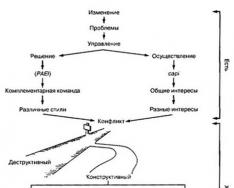The third group of reference business development strategies are diversified growth strategies. These strategies are implemented when the enterprise cannot further develop in a given market or with a given product within the industry. The main factors determining the choice of a diversified growth strategy are formulated:
markets for the business being carried out find themselves in a state of saturation or reduction in demand for the product due to the fact that the product is in the dying stage;
the current business generates income in excess of needs, and which can be profitably invested in other areas of the business;
a new business can cause a synergistic effect, for example, through better use of equipment, components, raw materials, etc.;
antimonopoly regulation does not allow further expansion of business within this industry;
tax losses can be reduced;
access to world markets may be facilitated;
new qualified employees can be attracted or the potential of existing managers can be better used
. Key strategies for diversified growth are:
the strategy of centralized diversification is based on the search and use of additional opportunities for the production of new products that are contained in the existing business; existing production remains at the center of the business, and new production arises based on those opportunities that are contained in the developed market, the technology used, or other strengths of the enterprise's functioning. Such possibilities, for example, may be the capabilities of the specialized distribution system used;
A horizontal diversification strategy involves seeking growth opportunities in an existing market through a new product that requires new technology that is different from the current one. According to this strategy, the enterprise should focus on the production of such technologically unrelated products that would use the existing capabilities of the company, for example, in the field of supplies. Because the new product must be aimed at the consumer of the main product, and in its qualities it must be complementary to the product already being produced. An important condition for the implementation of this strategy is a preliminary assessment by the enterprise of proprietary competence in the production of a new product;
The strategy of conglomerate diversification is that the enterprise expands through the production of new products that are technologically unrelated to those already being produced, which are sold in new markets. This is one of the most difficult development strategies to implement, since its successful implementation depends on many factors, in particular on the competence of existing personnel and especially the manager, seasonality in the life of the market, the availability of necessary funds, etc.
7314 Reduction Strategies
In some cases, an enterprise is forced to use one of the strategies for purposefully reducing activities. The implementation of these strategies is often not painless at an enterprise. However, it must be clearly understood that they cannot be avoided. There are four types of targeted business strategies:
elimination strategy represents an extreme case of a reduction strategy and is carried out when the enterprise cannot conduct further business;
harvest strategy involves abandoning a long-term view of business in favor of maximizing income in the short term. This strategy is applied to an unpromising business that cannot be sold profitably, but can generate income during the "harvest" This strategy involves reducing purchasing costs, labor costs and maximizing income from the sale of existing product, while continuing to reduce activities . The “harvest” strategy is designed to ensure that, with a gradual reduction of the business to zero, to achieve the maximum total income during the period of reduction;
reduction strategy is that an enterprise closes or sells one of its business units to effect a long-term change in the boundaries of its business. Often this strategy is implemented by diversified firms when one of the industries does not fit well with others. Such a strategy is also implemented when it is necessary to obtain funds for the development of more promising activities or the start of new activities that are more consistent with the long-term goals of the enterprise. There are other situations that require the implementation of a reduction strategy;
cost cutting strategy is quite close to a reduction strategy, since its main idea is to search for opportunities to reduce costs and carry out appropriate measures to reduce them. However, this strategy has certain distinct features, which are that it is more focused on eliminating fairly small sources of costs, and also that its implementation is in the nature of temporary or short-term measures. The implementation of this strategy is associated with a reduction in production costs, an increase productivity, reductions in hiring and even layoffs of personnel, the cessation of production of unprofitable products and the closure of unprofitable facilities. It can be considered that the cost reduction strategy turns into a reduction strategy when divisions or fixed assets begin to be sold in a sufficiently large volume.
In real practice, enterprises can simultaneously implement several strategies. This is especially common in diversified companies that can afford to develop (with the definition of a certain sequence e) the implementation of several strategies.
732 Competitive Strategies
The following main types of competitive strategies can be distinguished:
1 Cost leadership strategy - provides for a reduction in the total costs of production of a product or service, which attracts more consumers
2 . Broad differentiation strategy - aimed at giving the company’s products specific features that distinguish them from the products of competing enterprises, which, in turn, helps to increase the number of buyers
3 Optimal cost strategy - Enables customers to get more value for their money through a combination of low costs and broad product differentiation. The challenge is to ensure optimal costs and prices relative to manufacturers of products with similar features and quality.
4 . Market niche strategy (or focused strategy): based on low costs - focuses on a narrow segment
buyers, where the company is ahead of its competitors due to lower production costs;
based on product differentiation- aims to provide representatives of the selected segment with goods and services that best suit their needs and tastes
5 . Strategy bias - most often used by firms in industries that are at the initial stages of their life cycle, and associated with the formation of a strategic asset ahead of the curve, neutralism is not always achieved by competitors.
Send your good work in the knowledge base is simple. Use the form below
Students, graduate students, young scientists who use the knowledge base in their studies and work will be very grateful to you.
Similar documents
Types of business development strategies. Approaches to strategy development. Strategies for concentrated, integrated and diversified growth. Main tasks of strategy development. The concept of a strategic decision. Sequence of strategy development.
test, added 12/23/2010
The importance of strategy in the strategic management of a modern enterprise. Main areas and methods of strategy development. Reference development strategies: concentrated growth, integrated growth, diversified growth, reduction.
test, added 11/05/2007
Approaches to developing an organization's strategy in the market: concept, content, symbols and the right choice. Functional, portfolio and business strategies. Implementation of concentrated, integrated, diversified growth and contraction strategies.
test, added 07/22/2014
The essence and main goals of corporate strategy, its significance for the competitiveness of the organization. Characteristics of levels of strategic management. Features of strategies for growth, stability and withdrawal, their implementation in the activities of a sports club.
course work, added 09/28/2011
The place of strategic planning in production management. Strategies for a company's behavior in the market, conditions for their use. Corporate (portfolio) strategy. Comparative characteristics of strategic decisions. Types of integrated growth strategies.
course work, added 03/08/2014
Study of the essence of the concept of diversification. Elements of a diversified company's strategy. Criteria for the feasibility of diversification. Reasons prompting an enterprise to diversify its production. Types of corporate diversification strategies.
test, added 09/21/2010
Strategies for horizontal and reverse vertical integration. Methods for diversified growth. Model of strategic management of an organization. Improving the organizational structure of an organization focused on innovation.
course work, added 03/19/2016
Theoretical foundations and sources of diversification strategy. The role of resources and abilities as the foundation for the development of a company's strategy and the main sources of profit. Features of diversification in the sports industry, its advantages and disadvantages.
test, added 09/23/2016
In an effort to expand and develop your business, you must adhere to a specific plan and sequence of decisions and actions. Otherwise, if you act at random, thoughtlessly and suddenly, you may not only not advance anywhere, but also lose what you have already acquired. And after all, battles are won more likely by good strategists than by the commanders of the most numerous and well-equipped army.
In a modern business system, there are four main (reference) business development strategies: a concentrated growth strategy, an integrated growth strategy, a diversified growth strategy and a reduction strategy. Each of these systems is applicable in its own situation and solves a number of specific issues.
Strategies can be used in their pure form, or they can be combined and combined, for example, using simultaneously the methods of integrated growth and diversification strategies.
Integrated Growth Strategies
A stable enterprise that has well mastered its market and gained a foothold in it can try to apply integrated growth strategies. In a nutshell, this is the expansion of activities through the acquisition of new enterprises and industries or by increasing internal structures.
In turn, integrated growth strategies are divided into the approach of backward vertical integration and forward vertical integration.
Reverse vertical integration strategy
If an enterprise organizes new supply and purchasing departments, acquires companies involved in the supply of raw materials, opens new offices that produce not the main product, but, for example, spare parts or raw materials for it - this is all called the use of a reverse vertical integration strategy.
This approach allows you to reduce purchasing costs and keep your finger on the pulse of the situation with raw materials on the market.
Forward Vertical Integration Strategy
Forward vertical integration implies a reduction in the number of intermediaries between the enterprise itself and the end consumer. Using this strategy, you can buy out intermediary companies, hire new employees who will engage in intermediary activities, or even open your own branded stores, instead of selling products to other structures.
Diversified Growth Strategies
Sooner or later, any large enterprise comes to a point when the industry market has been fully developed, and all the changes that could be thought of have already been made to the product. Nevertheless, I want innovation and development. Then it is time to implement diversified growth strategies.
In turn, this reference business development strategy is divided into three approach options:
- horizontal diversification strategy;
- centered diversification strategy;
- conglomerate (conglomerate) diversification strategy.
Horizontal diversification strategy
Almost any enterprise producing any product can find a new industry in which it can apply its product. For example, a pharmaceutical manufacturer can acquire an existing pharmacy, a grain processing enterprise can acquire a confectionery factory, and so on.
This is the approach (strategy) of horizontal diversification: you continue to work with existing raw materials and personnel, but at the same time expand your horizons.
Centered Diversification Strategy
 The centered diversification strategy involves the release of a new product, using a completely new technology, but aimed at the same consumer. On the one hand, this is a complex process that requires management to master a new area of knowledge and, possibly, a new approach to management; not everyone may be ready for this and cope with it. On the other hand, if the plan is successfully implemented, the company will successfully invest funds and consolidate its position in several markets at once.
The centered diversification strategy involves the release of a new product, using a completely new technology, but aimed at the same consumer. On the one hand, this is a complex process that requires management to master a new area of knowledge and, possibly, a new approach to management; not everyone may be ready for this and cope with it. On the other hand, if the plan is successfully implemented, the company will successfully invest funds and consolidate its position in several markets at once.
This strategy is pursued, for example, by the management of the Hilton hotel chain, a brand known for its high class and level of service. Now the management is building a chain of suburban hotels, with much lower prices and smaller spaces, but maintaining the same level of service and maintaining the comfort and modernity of the rooms.
Conglomerate diversification strategy
p>Conglomerate (conglomerate) diversification involves the development of a completely new market and a new product that is in no way related to existing products and industry. The calculation in this case is based on consumer recognition of the brand. Of course, only a large and successful event can afford such a risk, but if successful, there is a chance of getting another profitable business.
For example, the large Ukrainian metallurgical plant Zaporizhstal has been producing high-quality sausage products that are recognizable and loved by consumers for several years.
Business blogs

